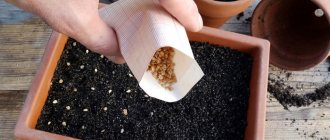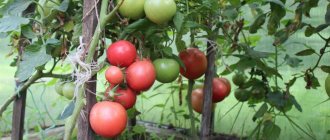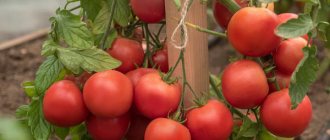Description of tomato Valentina
Tomato Valentina has been on the State Register since 1998. Its planting is allowed in any region of Russia. The variety is intended for open ground. It is recommended to grow it in garden plots and farms.
The plant is of a determinate type, non-standard, spreading. The branching of the shoots is weak, the number of leaves is below average. The height of the bush is 55-60 cm. The leaves are medium-sized, slightly corrugated, typical for tomatoes, green-yellow in color, and have stipules.
The inflorescences are simple. The first bud appears above the 7th leaf. The next inflorescences are laid every 1-2 leaves. The peduncle has an articulation. Fruiting begins on the 97th day after seed germination.
Description of fruits
Description and photo of tomato Valentina:
- medium sizes;
- fleshy pulp;
- smooth thick skin;
- elongated oval shape;
- The color of unripe fruits is light green, becoming orange-red as they ripen;
- number of sockets – 2 pcs.;
- weight from 80 to 87 g.
The taste of Valentina tomatoes is rated at a high level. Of the total harvest volume, 95-97% of tomatoes have commercial properties. Fruiting is not extended, all fruits ripen at the same time.
The nuances of breeding in open ground and in a greenhouse
The early tomato variety Valentina can be sown in open ground or a greenhouse and grown without the help of seedlings. To do this, sowing is carried out in the greenhouse and covered with additional shelter. In open ground, double shelter is also used over the sown seeds.
After germination, ventilation is carried out. Initially short-term, then the interval of keeping seedlings without shelter is increased.
When the air temperature reaches the optimum for tomatoes and frost is no longer possible, the seedlings are thinned out and transplanted to a permanent fruiting site.
Characteristics of tomato Valentina
Valentina tomatoes stand out among other varieties due to their characteristics. Gardeners especially value their productivity, universal use, and resistance to drought and disease.
Productivity and fruiting
The variety bears harvest in July-August. According to the description, Valentina tomatoes produce 12 kg of fruit per 1 sq. m landings. Up to 4 kg of tomatoes can be harvested from one bush. Tomatoes are planted in open areas. Planting under film cover is allowed. Yields are positively affected by the supply of water and minerals.
Area of application of fruits
Tomato Valentina has universal application. The fruits are consumed fresh for snacks and salads. Tomatoes are suitable for whole-fruit canning; they do not become soft during heat treatment.
Resistance to diseases and pests
Tomato variety Valentina is resistant to major diseases. To protect plantings from fungal diseases, follow the rules of care and perform preventive spraying. Insecticides or folk remedies are used against insects.
Advantages and disadvantages of the variety
Tomato Valentina deserves attention due to the following characteristics:
- drought resistance;
- friendly ripening of fruits;
- universal purpose of tomatoes;
- compact dimensions;
- do not require stepsoning;
- early fruiting.
A relative disadvantage of the Valentina tomato variety is the need for care. Tomatoes need watering, fertilizing, and tying up.
More about care
The description of the “Valentina” tomato and the captions under the photo show that special care for this variety is not required, however, tomatoes do not grow like weeds. Basic care for them is still necessary. Yes, this species does not require the creation of special soil or special conditions for ripening and increasing productivity. At the same time, professionals talk about the need to follow a few simple rules:
- Ensuring proper watering. This does not mean that you should fill tomato seedlings with water every day. Either a little bit every day, or once a week and very generously.
- Regular loosening of the soil. You can also loosen the soil around the sprout once a week.
- Frequently clearing the ground next to the seedlings from weeds. Weeds not only take water from the ground from the tomato, but also nutrients that are necessary for their proper and timely development.
- Spraying against insect pests. This variety is protected from common diseases, but it is not protected from insects that eat its foliage, flowers and roots.
- In a greenhouse, it is important to provide the plant with frequent ventilation. Once a day will be enough.
- If the seedlings are planted in open ground, at first they will need to be covered with film.
Warning! Watering plants should be done only with warm water, never cold.
Moreover, the water must be settled. That is why experienced gardeners have large containers on their plots in which they store water for irrigation.
Those who have been growing Valentina tomatoes for many years now willingly post a description of this variety and photos of their own harvest precisely because they have something to brag about. Beautiful appearance, amazing taste and unforgettable aroma - these are its main advantages.
Growing rules
To successfully grow Valentina tomatoes, a number of conditions are observed: prepare seeds for planting, care for seedlings and adult plants. Although the variety is considered unpretentious, good care will avoid diseases and increase productivity.
Planting seedlings
Wooden boxes or plastic containers are prepared for planting seeds of the Valentina variety. They are washed with warm water and soap. To avoid picking, it is convenient to use peat cups for seedlings. They take the soil from their plot or buy special soil for tomatoes. The soil is prepared in late autumn, and compost or humus must be added. To disinfect, the soil is heated in an oven or watered with a solution of potassium permanganate.
Advice! Planting of Valentina tomato seeds begins in March-April.
Pour soil into the container, lightly compact it and water it. The seeds are deepened by 1 cm and 1.5-2 cm are left between them. The next row is formed after 3 cm. The plantings are covered with film and kept in a dark place. To speed up the growth of tomatoes, maintain the temperature above + 24 °C. The polyethylene is constantly turned over and condensation is removed from it. In such conditions, the first shoots appear after 7-10 days.
Containers with sprouts are transferred to the windowsill. Styrofoam is placed under them to protect the tomatoes from the cold. Seedlings of the Valentina variety are provided with a number of conditions:
- temperature during the day is + 22-25 °C, at night – about + 18 °C;
- ventilation of the room;
- moderate humidity;
- continuous lighting 14 hours a day.
Water the tomatoes when the soil begins to dry out. Moisture is added using a spray bottle. Do not allow water to stagnate in the soil. Valentina tomato seedlings do not need fertilizing. If the plants do not have enough light, install additional phytolamps.
When the tomatoes have 2 leaves, start picking. Valentina tomatoes are planted in separate containers. The soil is used with a similar composition as for seeds. The strongest and most developed plants are selected. First, moisten the soil, then carefully remove the tomatoes from the boxes. The seedlings are transferred to the holes, their roots are covered with soil and watered.
Transfer
Tomatoes are prepared for transplantation at the age of 35-40 days. Work is usually carried out in May or early June. Wait until the soil warms up and warm weather sets in. If there is still a chance of frost, then at first the tomatoes are covered with agrofibre.
The beds for tomatoes are prepared in the fall: they are dug up and fertilized with humus. The culture grows well in sunny areas with fertile, light soil. It is best to choose an area for planting where cabbage, carrots, beets, onions, garlic or herbs grew the year before. It is not recommended to plant tomatoes immediately after potatoes, peppers, and eggplants.
Important! The place where tomatoes are grown is changed annually.
If it is not possible to create new beds, then completely change the top layer of soil 30-40 cm thick.
Valentine tomatoes are planted on a warm cloudy day. Holes with a depth of 15-20 cm are prepared for the plants. 40-50 cm are left between the tomatoes, 60 cm between the rows. For 1 sq. m place no more than 4 plants. The seedlings are transferred together with a clod of earth or a peat tablet. After planting, the tomatoes are not watered or fed for 2-3 weeks.
Aftercare
Valentina tomatoes are provided with moderate watering. Before flowering begins, moisture is added every week in the amount of 4-5 liters. When buds are forming, tomatoes are watered every 3 days, water consumption is reduced to 3 liters. In order for moisture to be absorbed faster, be sure to loosen the soil. It is important not to damage the roots of the tomatoes. Mulching will help reduce the number of waterings. A layer of straw or humus is poured onto the beds.
Tomatoes of the Valentina variety are fed for 2-3 weeks. Before flowering, add slurry or urea solution. The fertilizer contains nitrogen, which activates the active growth of shoots. During flowering and fruit formation, phosphorus-potassium fertilizers are introduced. Add 35 g of superphosphate and potassium salt to 10 liters of water. The tomatoes are watered with the solution at the root.
Attention! Tomatoes of the Valentina variety do not require pinching.
Although the Valentina variety is low-growing, it is tied to supports. This way the bushes bend towards the ground, and the fruits do not come into contact with the wet soil. A wooden plank or metal rod is used as a support.
Bush care
Basic measures for caring for plants of the “Valentina” variety:
- Regular and abundant watering;
- Loosening the soil in the beds;
- Weeding the area from weeds;
- Mulching beds with straw, peat or humus;
- Fertilizing with organic matter and mineral complexes.
When growing tomatoes in unprotected soil, the bushes do not need to be pinched, otherwise the yield may decrease. In greenhouses and greenhouses, vegetable growers recommend partially removing stepsons. It is recommended to tie the tomato stem to a support or trellis.
Pest and disease control
The most dangerous diseases for tomatoes are fusarium, late blight, and gray rot. The risk of disease spread increases with cold weather and frequent rainfall. To protect tomatoes of the Valentina variety, spray with fungicides Fitosporin, Horus, Khom. The preparations contain copper and inhibit the development of fungus. Instead of chemicals, use an infusion of wormwood, wood ash, and onion peel. The insecticides Iskra, Actellik, and Karbofos are effective against insects. Good prevention is compliance with agricultural practices. This includes rationing watering, loosening the soil, weeding, and moderate fertilizing with nitrogen substances.
Harvesting and application
Early tomatoes are always welcome. The Valentina variety will be the first to provide the vegetable grower with salad products. Harvesting is carried out as the fruits ripen. After enjoying the salads and sliced vegetables, you can move on to preparations.
Well-ripened tomatoes are used for:
- preservation in banks;
- pickling;
- cooking tomatoes in their own juice;
- production of tomato juice, sauce, ketchup.
The tomato variety, due to its elasticity and oval shape, is quite suitable for preparing sun-dried tomatoes in spices. Using a dryer or oven, you can create an excellent preparation for the winter.
Reviews from people
Farmer experience proves: pinching these tomatoes is not only unnecessary, but also undesirable. The best yields are achieved only without this procedure. A user of a gardening forum under the nickname Ovechka wrote about this. The woman also spoke about the experience of late planting of Valentina tomatoes. The fruits only managed to reach technical ripeness, but ripened perfectly in the pantry.
Valentina Tikhomirova (Smolensk region) confirms the high keeping quality of the fruit. In her case, the tomatoes ripened on a regular windowsill, without rot or darkening of the skin. There is debate on thematic forum threads about the presence of large potato leaves in the variety. Some gardeners claim that their tomatoes have just such greenery.
According to gardeners, the first tomatoes of the season grow more round than oval. Later, the new tomatoes will take on the familiar shape of an oblong cream. User Oksana confirmed the resistance of these tomatoes to diseases. She managed to reap a full harvest without any serious difficulties.
The Valentina tomato is adapted to the climate of the Russian Federation and is unpretentious in cultivation. The variety is also characterized by high yield and is convenient for pickling.
Growing experience: advantages and disadvantages of tomatoes
In the process of cultivating tomatoes of this variety, gardeners identified the following positive qualities:
- determinacy;
- undemanding to soil;
- small bush size, non-spreading form;
- increased drought resistance (short period);
- early achievement of ripeness;
- high stable yield;
- increased resistance to common tomato diseases;
- high shelf life, easy to transport (fruits do not crack or wrinkle);
Attention! The stems of the tomato bush are quite thin. Therefore, every adult plant definitely needs support. Otherwise, your crop will end up on the surface of the ground and spoil.
How to grow seedlings
Sowing seeds for seedlings begins 2 months before planting in the ground. Seed material must be prepared for planting in order to prevent a number of diseases and increase the quantitative indicator of fruiting.
Seedlings: what you need to know
The seeds of the variety are sown for seedlings in March, pre-soaking them in special solutions for disinfection and stimulation of germination.
Disinfection: seeds are dipped in a pink solution of potassium permanganate for 15 minutes, then washed thoroughly.
To improve germination, increase immunity: soaking tomatoes in a solution of Epin, Energen, infusion of wood ash, aloe juice.
Then the seeds are germinated in a damp cloth or gauze and sown in prepared boxes.
On a note ! Germinating seeds speeds up the emergence of seedlings.
After the first shoots of tomatoes appear, the boxes are exposed to light, the room temperature is reduced to +18ºC, and kept in this mode for about 4-5 days.
Then the temperature should be +22ºC...+24ºC until the end of growing the seedlings. Diving is mandatory; it is carried out when the tomatoes have 2-3 true leaves. They are transplanted into separate pots, and after 10-12 days they are fed with complex fertilizers.
Planting of seedlings - in May, the exact days are determined taking into account the weather and climate of the region.
Optimal timing for sowing
Valentina is an early ripening tomato, so seedlings are sown in the third decade of March.
Seed preparation
The grains are laid out on the table and carefully examined one by one for visible damage. Grains suitable for sowing must be light in color, without bends or defects. They are then placed in a saline solution for 10 minutes. Those seeds that have sunk to the bottom are washed with running water and disinfected in a weak solution of potassium permanganate for 20 minutes.










